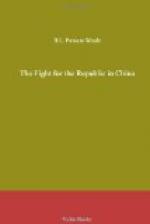The year 1914 dawned with so many obstacles removed that Yuan Shih-kai became more and more peremptory in his methods. In February the young Empress Lun Yi, widow of the Emperor Kwang Hsu, who two years previously in her character of guardian of the boy-Emperor Hsuan Tung, had been cajoled into sanctioning the Abdication Edicts, unexpectedly expired, her death creating profound emotion because it snapped the last link with the past. Yuan Shih-kai’s position was considerably strengthened by this auspicious event which secretly greatly delighted him; and by his order for three days the defunct Empress lay in State in the Grand Hall of the Winter Palace and received the obeisance of countless multitudes who appeared strangely moved by this hitherto unknown procedure. There was now only a nine-year old boy between the Dictator and his highest ambitions. Two final problems still remained to be dealt with: to give a legal form to a purely autocratic rule, and to find money to govern the country. The second matter was vastly more important than the first to a man who did not hesitate to base his whole polity on the teachings of Machiavelli, legality being looked upon as only so much political window-dressing to placate foreign opinion and prevent intervention, whilst without money even the semblance of the rights of eminent domain could not be preserved. Everything indeed hinged on the question of finding money.
There was none in China, at least none for the government. Financial chaos still reigned supreme in spite of the great Reorganization Loan of 25,000,000 pounds, which had been carefully arranged more for the purpose of wiping-out international indebtedness and balancing the books of foreign bankers than to institute a modern government. All the available specie in the country had been very quietly remitted in these troubled times by the native merchant-guilds from every part of China to the vast emporium of Shanghai for safe custody, where a sum not far short of a hundred million ounces now choked the vaults of the foreign banks,—being safe from governmental expropriation. The collection of provincial revenues having been long disorganized, Yuan Shih-kai, in spite of his military dictatorship, found it impossible to secure the proper resumption of the provincial remittances. Fresh loans became more and more sought after; by means of forced domestic issues a certain amount of cash was obtained, but the country lived from hand to mouth and everybody was unhappy. Added to this by March the formidable insurrection of the “White Wolf” bandits in Central China—under the legendary leadership of a man who was said to be invulnerable—necessitated the mobilization of a fresh army which ran into scores of battalions and which was vainly engaged for nearly half a year in rounding-up this replica of the Mexican Villa. So demoralized had the army become from long license that this guerilla warfare was waged with all possible slackness until a chance shot mortally wounded the chief brigand and his immense following automatically dispersed. During six months these pests had ravaged three provinces and menaced one of the most strongly fortified cities in Asia—the old capital of China, Hsianfu, whither the Manchu Court had fled in 1900.




